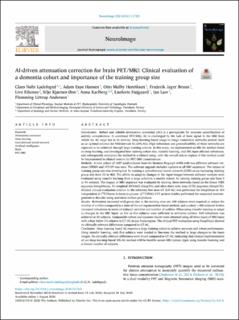| dc.description.abstract | Introduction
Robust and reliable attenuation correction (AC) is a prerequisite for accurate quantification of activity concentration. In combined PET/MRI, AC is challenged by the lack of bone signal in the MRI from which the AC maps has to be derived. Deep learning-based image-to-image translation networks present itself as an optimal solution for MRI-derived AC (MR-AC). High robustness and generalizability of these networks are expected to be achieved through large training cohorts. In this study, we implemented an MR-AC method based on deep learning, and investigated how training cohort size, transfer learning, and MR input affected robustness, and subsequently evaluated the method in a clinical setup, with the overall aim to explore if this method could be implemented in clinical routine for PET/MRI examinations.
Methods
A total cohort of 1037 adult subjects from the Siemens Biograph mMR with two different software versions (VB20P and VE11P) was used. The software upgrade included updates to all MRI sequences. The impact of training group size was investigated by training a convolutional neural network (CNN) on an increasing training group size from 10 to 403. The ability to adapt to changes in the input images between software versions were evaluated using transfer learning from a large cohort to a smaller cohort, by varying training group size from 5 to 91 subjects. The impact of MRI sequence was evaluated by training three networks based on the Dixon VIBE sequence (DeepDixon), T1-weighted MPRAGE (DeepT1), and ultra-short echo time (UTE) sequence (DeepUTE). Blinded clinical evaluation relative to the reference low-dose CT (CT-AC) was performed for DeepDixon in 104 independent 2-[18F]fluoro-2-deoxy-d-glucose ([18F]FDG) PET patient studies performed for suspected neurodegenerative disorder using statistical surface projections.
Results
Robustness increased with group size in the training data set: 100 subjects were required to reduce the number of outliers compared to a state-of-the-art segmentation-based method, and a cohort >400 subjects further increased robustness in terms of reduced variation and number of outliers. When using transfer learning to adapt to changes in the MRI input, as few as five subjects were sufficient to minimize outliers. Full robustness was achieved at 20 subjects. Comparable robust and accurate results were obtained using all three types of MRI input with a bias below 1% relative to CT-AC in any brain region. The clinical PET evaluation using DeepDixon showed no clinically relevant differences compared to CT-AC.
Conclusion
Deep learning based AC requires a large training cohort to achieve accurate and robust performance. Using transfer learning, only five subjects were needed to fine-tune the method to large changes to the input images. No clinically relevant differences were found compared to CT-AC, indicating that clinical implementation of our deep learning-based MR-AC method will be feasible across MRI system types using transfer learning and a limited number of subjects. | en_US |

